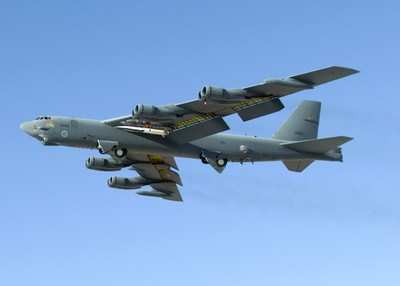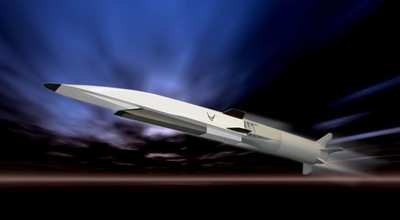Flight is Key Milestone For Hypersonic Vehicle
 The X-51A WaveRider was carried
aloft for the first time Dec. 9 by an Air Force Flight Test Center
B-52 Stratofortress over Edwards Air Force Base, Calif. The
test was a key milestone in the X-51 test program. In 2010,
USAF officials plan to light its supersonic combustion ramjet
engine and propel the aircraft at hypersonic speed for about five
minutes before plunging it into the Pacific Ocean.
The X-51A WaveRider was carried
aloft for the first time Dec. 9 by an Air Force Flight Test Center
B-52 Stratofortress over Edwards Air Force Base, Calif. The
test was a key milestone in the X-51 test program. In 2010,
USAF officials plan to light its supersonic combustion ramjet
engine and propel the aircraft at hypersonic speed for about five
minutes before plunging it into the Pacific Ocean.
"This was a great day for the program," said Charlie Brink,
X-51A program manager with the Air Force Research Laboratory at
Wright-Patterson AFB, Ohio. "The early look is we successfully
captured all of our test points without any anomalies. I'm really
proud of the AFRL, Air Force Flight Test Center, and Boeing/Pratt
Whitney Rocketdyne teams' efforts to move us toward the big event.
That flight test is currently planned in about two months, he
said.
The Dec. 9 test, reminiscent of the early days of the historic
X-15 program 50 years earlier, was conducted entirely in the
airspace over Edwards AFB while various systems and telemetry were
checked out. The Flight duration was 1.4 hours.
"After takeoff we climbed to 50,000 feet and verified B-52
aircraft performance, handling qualities with the X-51A attached to
the B-52, control room displays and software integration with the
X-51A," said Lt. Col. Daniel Millman, a B-52 project pilot. "The
B-52 handled great and the flight preceded as planned."
The next B-52/X-51 flight test mission is expected in
mid-January, and will be a full dress rehearsal for its first
hypersonic test flight, now planned for mid-February, Mr. Brink
said. The dress rehearsal flight will depart Edwards AFB and head
out over the Pacific to Point Mugu Naval Air Warfare Center Sea
Range. Both airborne and multiple ground test assets will monitor
all X-51A systems, but it will not be released from the B-52 and
its engine will not ignite.

U.S. Air Force photo/Mike
Cassidy
In February, the Air Force Flight Test Center's B-52 will carry
the unmanned X-51A to approximately 50,000 feet over the Pacific
Ocean then release it. A solid rocket booster from an Army Tactical
Missile System will then ignite and accelerate the X-51 to about
Mach 4.5. Then the booster will be jettisoned and the X-51A's
supersonic combustion ramjet propulsion system will ignite and
operate for about 300 seconds, propelling the cruiser to more than
six times the speed of sound.
Onboard sensors will transmit data to ground systems before the
cruiser plunges into the Pacific. There are no plans to recover the
craft.
Four X-51A cruisers have been built and were developed by
officials from the Air Force, Defense Advanced Research Projects
Agency, Pratt & Whitney Rocketdyne and Boeing. Boeing's Phantom
Works performed overall air vehicle design, assembly and testing
for the X-51's various components.
Pratt & Whitney Rocketdyne built the X-51's scramjet engine.
Engineers expect a great deal will be learned about hypersonic
flight during the nearly 300 seconds under scramjet power. The
longest-ever previous scramjet test, lasted only about 10 seconds,
Mr. Brink said.
As the engine ignites it will initially burn a mix of ethylene
and JP-7 fuel before switching exclusively to JP-7. The X-51's
fuel-cooled engine design will both heat the JP-7 to an optimum
combustion temperature and help the engine itself endure extremely
high operating temperatures during the long burn.
Previous important ground tests verified the X-51 and B-52 could
communicate electronically and that X-51A can be safely and
successfully uploaded and downloaded on the modified B-52H pylon.
Wind tunnel tests and modeling to ensure safe separation from the
aircraft were other prerequisites.
Program officials said the scramjet motor's great advantage is
the ability to capture and burn oxygen in the thin atmosphere,
rather than having to carry it in a large tank like the space
shuttle or other rockets. Not having to carry the oxidizer needed
for combustion means more payload capability.

Beyond scalable scramjet propulsion, other key technologies that
will be demonstrated by the X-51A include thermal protection
systems materials, airframe and engine integration, and high-speed
stability and control.
Boeing officials said they also had to demonstrate the X-51A 's
compatibility with the electromagnetic environment of the B-52H
aircraft. The test verified that the X-51A can be powered by and
communicate with the B-52H using a modified Joint Direct Attack
Munition interface.
"Adapting existing, proven hardware, helps us keep program costs
down," Mr. Brink said.
Mr. Brink said he believes the X-51A program will provide
knowledge required to develop the game changing technologies needed
for future access to space and hypersonic weapon applications.
 ANN's Daily Aero-Linx (04.16.24)
ANN's Daily Aero-Linx (04.16.24) Aero-News: Quote of the Day (04.16.24)
Aero-News: Quote of the Day (04.16.24) Airborne 04.10.24: SnF24!, A50 Heritage Reveal, HeliCycle!, Montaer MC-01
Airborne 04.10.24: SnF24!, A50 Heritage Reveal, HeliCycle!, Montaer MC-01 Airborne 04.12.24: SnF24!, G100UL Is Here, Holy Micro, Plane Tags
Airborne 04.12.24: SnF24!, G100UL Is Here, Holy Micro, Plane Tags Airborne-Flight Training 04.17.24: Feds Need Controllers, Spirit Delay, Redbird
Airborne-Flight Training 04.17.24: Feds Need Controllers, Spirit Delay, Redbird





